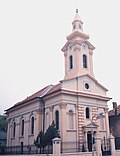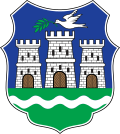
Religious architecture in Novi Sad is very diverse. Majority of the believers in Novi Sad are from Serbian Orthodox Church, while others are from Roman Catholic Church, many Protestant churches, and Jewish community. Stari Grad is the place with the majority of churches and temples, and they were all built in the 18th and 19th century.
Contents
- Orthodox churches
- Roman Catholic churches
- Protestant churches
- Greek Catholic church
- Jewish and Muslim religious buildings
- Latter-day Saints
- Jehovah's Witnesses
- See also
- References
- Citations
- Sources
- External links
The oldest religious building in the city was Orthodox church dedicated to Saint John. This church was built in 1700, but was burned in the 1848–49 revolution. It was rebuilt in 1853, but was razed in 1921.



































